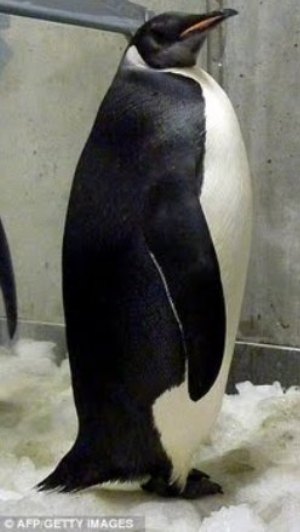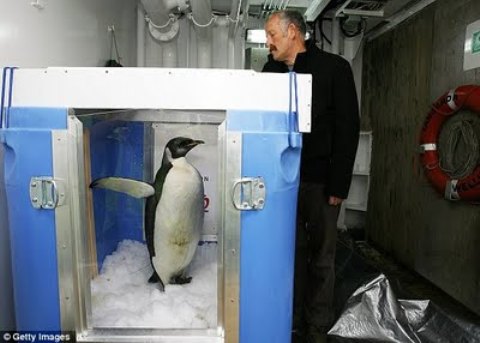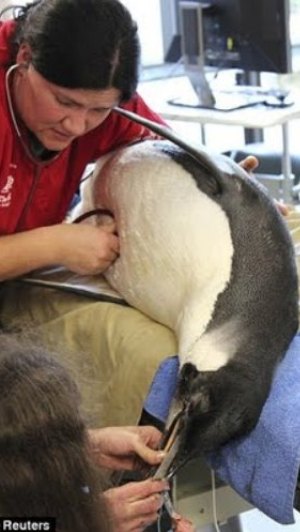An Emperor penguin, affectionately dubbed Happy Feet, who somehow got way off track from his frozen Antarctic home to end up almost 2000 miles away from home on a New Zealand beach this past June is now heading home.
On August 29, after a farewell party at the zoo with 1,700 fans, Happy Feet was transferred to a National Institute of Water and Atmospheric Research vessel, the Tangaroa, which set sail for the Campbell Islands, 700km south of New Zealand. A specially built iced-down crate and a diet of fish kept him comfortable on the four day journey back to his native range.
Happy Feet, equipped with a satellite tracking device, was released from the research vessel about 50 miles north of the remote Campbell Island.
Happy Feet apparently needed a nudge to leave the crate he had been kept in for six days while on the vessel. But he then slid down a makeshift ramp backwards and took off into the sea, heading in the right direction.
Wellington Zoo chief executive Karen Fifield said, “We have a bittersweet moment, I think, for the zoo. We are a bit sad to see Happy Feet go.”
Eleven weeks ago on June 20, the three foot tall emperor penguin was found walking on Peka Peka Beach, north of Wellington on the North Island’s western coast, in New Zealand by Christine Wilton who was walking her miniature schnauzer dog Millie when she came upon the penguin.
“It was out of this world to see it … like someone just dropped it from the sky,” said Christine Wilton.
Native to Antarctica, this was the first sighting of an emperor penguin in New Zealand in 44 years. Emperors are the largest of the penguin species. Adults grow to more than a meter tall and weigh up to 30 kilograms.
Wildlife officials had originally planned to leave the young penguin alone in the hopes that his natural instincts would guide him back home. However, intervention was deemed necessary after the penguin ingested over 7 pounds of beach sand and sticks, likely mistaking it for the snow he would usually eat to stay hydrated.
After being transported to the Wellington Zoo, the penguin underwent three medical procedures to remove the sand and other debris from his stomach and had since been living in a special temporary habitat while he recuperated.
After surgery, Happy Feet spent the past several weeks recovering in a small, ice-filled specially air-conditioned pen. The Wellington Zoo installed a webcam in his pen to allow people to watch his recovery online and the three-year-old penguin became a sensation. $28,000 in donations came in from fans to help pay for his surgery and care.
The homeward-bound journey of Happy Feet can be followed online thanks to the Havelock North-based company Sirtrack, which fitted him with a tracking device.
Sirtrack, with 25 years of experience in wildlife tracking, designed and built the satellite transmitter, and created a website so people can watch the penquin’s journey back to Antarctica.
The KiwiSat 202 tracking device, fitted to Happy Feet’s feathers using glue and tape, won’t affect his ability to swim and is designed to fall off when the bird moults in March or April next year. The device, about the size of a Matchbox car, weighs less than 1 per cent of Happy Feet’s body weight.
Sirtrack CEO Mike Kelly said the device will send signals from Happy Feet via satellite for about three hours twice a day.
“It is a unique situation to monitor a penguin in an unfamiliar habitat this far north, and a great opportunity for New Zealand and the world to look at what this animal is doing.”
Follow Happy Feet’s journey on www.nzemperor.com and twitter@NZEmperor.
As Happy Feet heads home, Don Wilson from Paraparaumu on the Kapiti Coast north of Wellington New Zealand has written and recorded this song ‘The Ballad of Happy Feet’ dedicated to all fans of Happy Feet……farewell, Happy Feet!
As emperor penguins can live for up to 50 years, the whole world is wishing Happy Feet a safe journey home and a long and happy life back home.
 CY@CY Says Welcome to my dreamscape. Where a Lim is also a Ling.
CY@CY Says Welcome to my dreamscape. Where a Lim is also a Ling.




